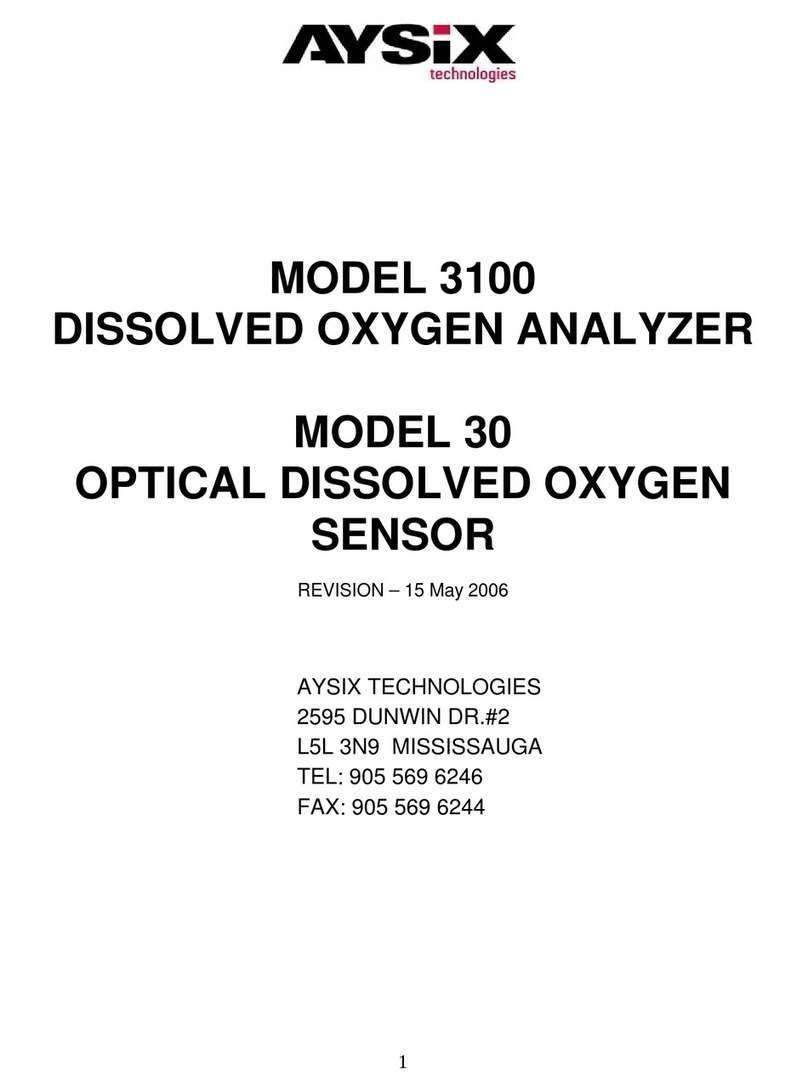
10
SENSORSETUP
Each channel has its own sensor setup menu. The analyzer will select the appropriate menu for the
type of sensor that is currently connected to each channel.
DO Sensor
General
The Model 10 sensor has been designed to require very infrequent calibration. Unlike polaragraphic
systems, light fouling of the sensing element should not affect the accuracy of the reading, but should only
slow the response time of the system. (However, heavy biological fouling that prevents reasonable sensor
contact with the water will cause erroneous readings.) With the sensor kept reasonably clean, the
calibration should hold for 6 months to 2 years, depending upon conditions.
Note: The Model 10 D.O. sensor undergoes a
thorough and accurate test and calibration
procedure before shipment from the factory.
Calibration of the D.O. reading at startup is not
necessaryand is not recommended.
The Model 2000 analyzer allows the user to select from two different calibration procedures. The
procedure can be selected by choosing SETUP from the main menu. Once the SETUP menu appears,
use the arrow keys to choose the “SENSOR x SETUP” option where x is the channel number of the
desired sensor.
Sensor Calibration to a Reference
Calibration to a known reference is the easiest, simplest, and also the preferred method of calibration
when calibration is required. Calibration option number 1 “Sensor Ref Cal” allows the operator to make
adjustments to the D.O. reading to agree with any other source of D.O. information. THIS CALIBRATION
PROCEDURE MUST ONLY BE USED ON A CLEAN SENSOR. IF THE SENSOR IS READING
ERRONEOUSLY DUE TO HEAVY BIOLOGICAL FOULING, USE OF THIS CALIBRATION METHOD
WILL RESULT IN UNRELIABLE RESULTS. The sensor must be stable in the water to be used as a
reference before beginning this procedure. From the SENSOR SETUP menu, choose the “Sensor Ref
Cal” option, and press ENTER. The analyzer will now read the sensor for the period of time indicated by
the “dampening” parameter, and display the result as D.O. in PPM. If this result matches the reference,
simply press ENTER to exit. Otherwise, use the arrow keys to adjust the reading to match the reference
value, and then press ENTER to store this new value. This procedure is primarily an adjustment to the
offset value of the sensor, but an adjustment in slope will also be made when this procedure is performed.
Sensor Slope Adjustment (NOT RECOMMENDED)
If performed correctly, the previously described “Sensor Calibration to a Reference” should be all that
is required by the user. “Sensor slope adjustment” should only be attempted upon recommendation from
the factory.
Sensor calibration option 2 “Sensor Slope Adj” allows the user to adjust the span of the sensor, but
this procedure must only be used immediately AFTER the sensor has been “zeroed” using calibration
option 1 with the sensor submerged in a zero oxygen solution. This zero solution may be prepared by
adding two tablespoons of sodium sulfite salt to a gallon of tap water in an open container (bucket). The
sodium sulfite salt will remove all oxygen from the water as it dissolves. Stir the water for about one




























